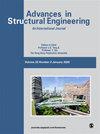Transient MHD Darcy-Forchheimer of Williamson-Casson flow with CCS: Application of wastewater treatment
IF 2
4区 工程技术
引用次数: 0
Abstract
With regards to the Cattaneo-Christoph (CCS) speculation, the thermal and mass transfer of a MHD Williamson-Casson ferrofluid flow through a permeable medium obeying the Darcy-Forchmeier law through an extended chamber or slab is carefully considered. The chemical reaction and Buongiorno nanofluid model were modified in the model to describe the nanoscale properties of liquid particles. Heat sources can be divided into two categories: linear and exponential space-dependent convection heat sources. The entire governing equations are changed to common differential terms, using a reasonable similarity change. These equations and their associated boundary conditions are calculated numerically via the fourth-order Runge-Kutta method. Comparison was made with the analytical solution in a special case, and very good agreement was reached. Economic success with deeper water purification can be attained by developing models for wastewater treatment facilities, conducting experiments and calculations on them, and making predictions for their nature in order to improve their cleaning efficiency, Prevent issues from arising during construction, operation, and reconstruction. The structural parameters of the quencher were physically modeled using mathematical modeling; It is possible to establish a cost-effective and effective filter model for industry and small settlements using the calculations and vertical filter model created in the article. Furthermore, it will be feasible to produce. Our mathematical procedure assure that: the deposit’s mass will be diminished through treated water under attractive field impacts; The magnetic field openness with nanometer-sized particles modifies the physical and synthetic properties of water particles bringing about exceptional characteristics; the water concentration will be decreased with the increase in the bending modulus; This means that in wastewater treatment the sediment mass will decrease.威廉姆森-卡森(Williamson-Casson)流的瞬态 MHD 达西-福克海默(Darcy-Forchheimer)与 CCS:废水处理的应用
关于卡塔尼奥-克里斯托夫(CCS)推测,仔细考虑了通过符合达西-福克迈尔定律的渗透介质的 MHD 威廉森-卡森铁流体流经扩展腔室或板的热量和质量传递。模型中修改了化学反应和 Buongiorno 纳米流体模型,以描述液体颗粒的纳米级特性。热源可分为两类:线性热源和指数空间对流热源。利用合理的相似性变化,将整个控制方程改为普通微分项。这些方程及其相关边界条件通过四阶 Runge-Kutta 方法进行数值计算。在特殊情况下,与分析解法进行了比较,结果非常吻合。通过开发废水处理设施模型、对其进行实验和计算,并对其性质进行预测,以提高其净化效率,防止在建设、运行和重建过程中出现问题,可以在深层水净化方面取得经济上的成功。利用数学建模对淬火器的结构参数进行了物理建模;利用文章中创建的计算和垂直过滤器模型,有可能为工业和小型居住区建立一个经济有效的过滤器模型。此外,该模型的生产也是可行的。我们的数学方法确保:在吸引力场的影响下,经过处理的水会减少沉积物的质量;纳米级颗粒的磁场开放性会改变水颗粒的物理和合成特性,从而带来特殊的特性;水的浓度会随着弯曲模量的增加而降低;这意味着在废水处理中,沉积物的质量会减少。
本文章由计算机程序翻译,如有差异,请以英文原文为准。
求助全文
约1分钟内获得全文
求助全文
来源期刊

Advances in Mechanical Engineering
Engineering-Mechanical Engineering
自引率
4.80%
发文量
353
期刊介绍:
Advances in Mechanical Engineering (AIME) is a JCR Ranked, peer-reviewed, open access journal which publishes a wide range of original research and review articles. The journal Editorial Board welcomes manuscripts in both fundamental and applied research areas, and encourages submissions which contribute novel and innovative insights to the field of mechanical engineering
 求助内容:
求助内容: 应助结果提醒方式:
应助结果提醒方式:


